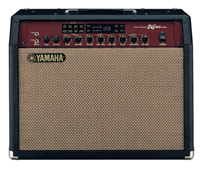Yamaha DG80-210 Guitar Amp
|
|
|
Yamaha DG80-210 Guitar Amp | |
| by John Sommer | |
|
| |
 Why would a guitar player (me) with a studio chock full of vintage, tube amplifiers, even consider using this digital Wunderkind? Well it took just five minutes at the helm of this "eighth wonder of the guitar amp world" for this "tubehead" to come round. My arms had to be twisted to get me to try it, but once I did, my hat was tipped to the technical wizardry of Yamaha. The combination of features gives the player access to a virtually unlimited array of sounds that rivals any of my vintage amps.
Why would a guitar player (me) with a studio chock full of vintage, tube amplifiers, even consider using this digital Wunderkind? Well it took just five minutes at the helm of this "eighth wonder of the guitar amp world" for this "tubehead" to come round. My arms had to be twisted to get me to try it, but once I did, my hat was tipped to the technical wizardry of Yamaha. The combination of features gives the player access to a virtually unlimited array of sounds that rivals any of my vintage amps.
At a MSRP of $1,299, this combo amp has a retro-styled, open-backed cabinet fronted with an easily accessible control panel that houses both a digital display and a full complement of manual/servo-controlled knobs. Yes, all the tone knobs and effect mix controls "rotate" when you call up a memory selection to the exact positions they were when you last used those settings. Even though the tone and sound changes instantly when you recall a new memory location, the knobs slowly move into position. Recallable are eight basic pre-amps: Lead 1 and 2, Drive 1 and 2, Crunch 1 and 2 and Clean 1 and 2. Also on-board and recallable are digital effects including: three reverbs (spring, hall and plate); tremolo; gain (distortion); tape echo and chorus. Yamaha has opted (wisely) not to include the master volume (called Output) and the input level (called Trim) in the memory function. Besides the multiple tone and effects controls, there are MIDI in and out jacks and an XLR output connector for directly recording a simulated but realistically miked speaker sound. In addition to 80 presets with names like Jazzin', Soul Food or Dr. Punk, there are 128 programable memories. You can modify a factory preset and then name and store it in a user-memory location. Presets in memory can be off-loaded to your computer via MIDI System Exclusive Dumps and you can use a not-included MIDI Footswitch controller to step through memory locations as well as make "on-the-fly" parameter changes. All of this technology is coupled to 80-watts of power and two Celestion vintage ten-inch speakers. The circuitry of the DG80 is based on digital modeling so there are no tubes, but I swear when this analogue freak took a vintage Les Paul flame-top, added a touch of Drive, a hair of echo and a little gain, I could hear my 6L6s vibrating. I've tried many other solid state and hybrid types of amps...for me NOT. This thing spun my head around, and that tube rattle, that growl and warmth that I get particularly with "tweed" era gear, the DG80 delivers. In the studio, I generally prefer a miked amp; the DG80 is exceptional in that it is noise-free even with numerous effects loaded and cranked. The speaker simulator feature comes in handy in situations where leakage and noise are issues or simply where miking may not be practical. Not lightweight; it appears to be built like a tank, although I didn't do a test-drop out of an airplane! The unit is easily transportable and is adaptable to any AC mains on the planet. Contact Yamaha Corp. of America, Pro Audio and Combo Division, Guitar Products P.O. Box 6600 Buena Park Ca., 90622-6600. Phone Them at: 714-522-9001 or e-mail: info@yamaha or Web to: www.yamaha.com John Sommer is an LA-based guitarist and songwriter who spends a good deal of time composing in his treehouse. |
|
|
|
Web Page Design Is Copyrighted ©1994 Through By Barry Rudolph